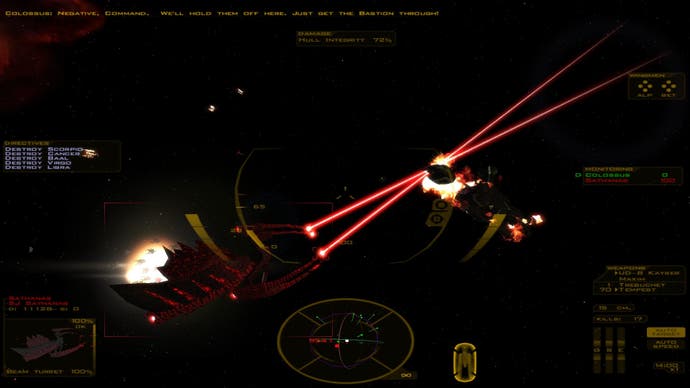Retrospective: Freespace 2
Everything but the void.
Freespace 2 was released in 1999, over a decade ago. It's an interesting case because, for one, it's never been surpassed. Since then, we've had the odd Freelancer, or X3, but they've not touched on the same high notes, and the things they've done well aren't the things Freespace 2 even attempted. It's peerless, which means it's in a bit of a vacuum when it comes to aging. Or would be, if things had remained the same. But I'll get to that.
On release, it was a critical darling, as well it should be, but it went down in flames, flopping commercially and sounding a death knoll for the genre as a whole. Volition went on to make Red Faction and Saint's Row, and left their space-faring days behind them. And that would be that, except, in a flair of generosity, they made the source code to Freespace 2 available to all in 2002, essentially handing over the reins of space simulation to the fans.
Play Freespace 2 today and you'd be forgiven for laughing incredulously when told that it's over a decade old. Half a decade old, even. Two or three years, perhaps, but the game has been under such heavy cosmetic surgery, under such skill and passion, that this isn't a 10-year-old game anymore. This is the best space sim ever released given the due care and attention it so rightly deserved, to make it an experience that looks as good as it plays. The Freespace 2 Source Code Project is genuinely incredible.
Beam cannons cut into capital ships, paused for a moment by the hull before they come charging out the other side in an explosive, flaming lance that lights up the void. Missile trails arc delicately before they home in on your aspect lock. Small fires litter ships like blemishes, ruining that perfect, pristine exterior with the pockmarks of battle. And, when they're on their last legs, huge cruisers and juggernauts shudder with crackles of electricity, seeming to be the only thing keeping them together.

Don't get me wrong; when Freespace 2 was released, it was beautiful. But as with everything, beauty is a subjective, comparable thing, and the unrelenting onslaught of graphical power left it behind. The modding scene has been playing catchup ever since, introducing things like normal mapping, and spectral lighting. All the tricks that modern games use, retrofitted into a 10-year-old engine.
Near the end of the 24th Century, the Galactic Terran-Vasudan Alliance (GTVA) is putting the last few stragglers of the Neo-Terran Front rebellion to rest. For the first few missions of the game, you're fighting ships not too dissimilar from your own, dogfighting with bombers and fighters or targeting the specific subsystems of capital ships to leave them open to attack from your own space-faring behemoths.
The brilliance comes in how the game treats objectives. They're not win conditions, and they're basically treated as best-case scenarios. You're going to get screwed over out there, in the nothingness of space, and quite often it's not going to be your fault. Given a convoy of five ships, you'll be lucky to make it to your destination with even half intact. Suffering no losses is going to get you a medal, not just the ability to go on to the next level. It's about acceptable losses. So instead of getting frustrated each time you fail to protect a capital ship because it means you have to start again, the blow of that loss is suddenly felt, purely because you can continue. You let that ship down, and it's not coming back.
Then, the entire second act is centred around a mysterious Nebula that's on the other side of an enigmatic artificial jump gate.








